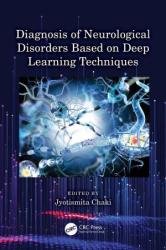 Название: Diagnosis of Neurological Disorders Based on Deep Learning Techniques
Название: Diagnosis of Neurological Disorders Based on Deep Learning TechniquesАвтор: Jyotismita Chaki
Издательство: CRC Press
Год: 2023
Страниц: 237
Язык: английский
Формат: pdf (true)
Размер: 13.8 MB
This book is based on Deep Learning approaches used for the diagnosis of neurological disorders, including basics of Deep Learning algorithms using diagrams, data tables, and practical examples, for diagnosis of neurodegenerative and neurodevelopmental disorders. It includes application of feed-forward neural networks, deep generative models, convolutional neural networks, graph convolutional networks, and recurrent neural networks in the field of diagnosis of neurological disorders. Along with this, data preprocessing including scaling, correction, trimming, and normalization is also included.
Deep Learning does not use hand-crafted features and have successfully been adapted to solve the medical diagnostic problems. As a result, Deep Learning is now playing an important role in the advancement of medical diagnostics. This is basically the need for a new book in the field of neurological disorder diagnostics based on Deep Learning. To my knowledge, this is the first book to offer a detailed description of the Deep Learning approaches used in the field of neurological disorder diagnostics. This book demonstrates the core concepts of Deep Learning algorithms that, using diagrams, data tables, and examples, are especially useful for deep learning-based human neurological disorder diagnostics. After introducing the basic concepts of deep learning-based diagnosis for neurological disorders, this book will examine Deep Learning techniques for modeling the diagnosis and the properties and merits of the Deep Learning network models. This book will cover two major areas of human medical diagnosis: neurodegenerative disorders and neurodevelopmental and psychiatric disorders.
A particular focus is placed on the application of feed-forward neural networks, deep generative models ( e.g., stacked auto- encoders, deep belief networks, deep Boltzmann machine, and generative adversarial networks), convolutional neural networks, graph convolutional networks, and recurrent neural networks in the field of diagnosis of neurological disorders. Along with this, the focus is also on data preprocessing which will include scaling, correction, trimming, and normalization of data. The theory behind each Deep Learning architecture will be supported by practical examples (case studies) in this book. This book will also cover the technique to select the most effective deep model for the diagnosis of neurological disorders as well as the deep learning-based effective treatment for the same. Lastly, highlights will be on how the use of deep neural networks can address new questions and protocols, as well as improve upon existing challenges in diagnosis of neurological disorders. This book will assist scholars and students who might like to learn about this area as well as others who may have begun without a formal presentation. It is comprehensive, but it prohibits unnecessary mathematics. The subject’s coverage is exceptional and has much of the principles needed to understand Deep Learning if anyone is searching for depth. This book is intended for professionals looking to gain proficiency in these technologies but is turned off by the complex mathematical equations.
Image filtering techniques are used to modify the image when deploying an application. Using these techniques, the characteristics or its appearance is changed to remove any noisy features and improvise the images by smoothing, sharpening, and edge enhancement. In particular, in image processing, the Gaussian filtering, box filtering, median filtering, and other variations among them are explored in great detail. In this work, the experiments were conducted using the ADNI dataset, and Python code was written using the Jupyter Notebook.
- Offers a detailed description of the Deep Learning approaches used for the diagnosis of neurological disorders.
- Demonstrates concepts of Deep Learning algorithms using diagrams, data tables, and examples for the diagnosis of neurodegenerative, neurodevelopmental, and psychiatric disorders.
- Helps build, train, and deploy different types of deep architectures for diagnosis.
- Explores data preprocessing techniques involved in diagnosis.
- Includes real-time case studies and examples.
This book can be useful for a variety of readers, but I have considered three target audiences in mind. Some of these target audiences are university students ( undergraduate, graduate, or postgraduate) learning about Deep Learning, including those who are beginning a career in Deep Learning research. The other target audiences are researchers and practitioners who do not have a Deep Learning background but want to rapidly acquire one and begin using Deep Learning in their product or platform.
Скачать Diagnosis of Neurological Disorders Based on Deep Learning Techniques